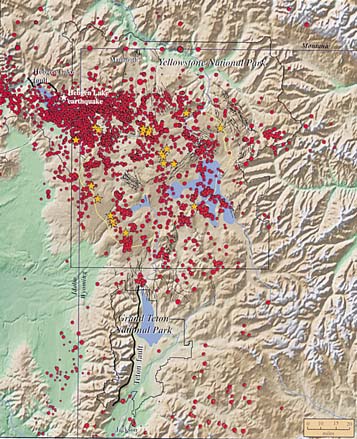
This Article From Issue
May-June 2000
Volume 88, Number 3
DOI: 10.1511/2000.23.0
Windows Into the Earth: The Geologic Story of Yellowstone and Grand Teton National Parks. Robert B. Smith and Lee J. Siegel. 224 pp. Oxford University Press, 2000. $40.
Yellowstone National Park is one of the more seismically active areas in the country, in large part because of a magma chamber that currently lurks beneath the park. It is that magma chamber that also drives the geothermal activity that has made Yellowstone a national treasure. Over the past 2 million years, the pressures associated with the movement of the magma, along with the slow movement of the North American plate over the stationary magma chamber, have led to cataclysmic events that, if they occurred today, would dwarf most other events in recorded history. During this period, at intervals of every 630,000 years or so, a massive caldera-forming volcanic explosion has occurred in or very near present-day Yellowstone National Park. The ash volume released during the three most recent events far surpassed that of Mount St. Helens and left deposits up to a foot thick hundreds of miles from the park.

Robert B. Smith is a leading investigator of the origin, geologic history and disaster potential of Yellowstone and Grand Teton National Parks. He has actively studied those areas for more than 30 years. Lee Siegel has written about general science, with an emphasis on geology, for more than 23 years. In Windows Into the Earth, they have assembled an interesting series of geologic histories and scenarios that address the creation of Yellowstone and Grand Teton, the modifications to the landscapes that have occurred through time and the potential for volcanic explosions and earthquakes.
They present a chilling account of the 1959 magnitude-7.5 earthquake and associated landslide near Hebgen Lake, Montana, just outside the west entrance to Yellowstone National Park. Twenty-eight people died, most as a result of the devastating landslide that dammed the Madison River. The earthquake also generated large waves, or seiches, in nearby Hebgen Lake, some of which overtopped the Hebgen Dam, 87 feet high. This earthquake is considered to be a model for events predicted for western and southwestern Wyoming and for the Wasatch Front in Utah.

From Windows Into the Earth
The Teton Range formed as a result of movement for many millions of years along the active Teton fault. Every few thousand years, the fault has moved, generating magnitude 7.0 to 7.5 earthquakes. The fault is now considered to be overdue for activation. Today, a magnitude-7.5 earthquake on the fault would cause death and considerable damage in Jackson Hole and surrounding areas. The authors address many disaster scenarios that could occur with such an event.
The photographs and diagrams are spectacular. Two interesting driving tours that cover both parks introduce readers to some of the most spectacular scenery in the country and are entertaining and informative.
Windows Into The Earth bridges the gap between highly technical analyses—of the Yellowstone hotspot, volcanism and active fault dynamics—and publications written for general audiences. Scientists and students of science will develop a reasonable understanding of specific earth processes, cataclysmic events and disaster prediction from this book. The public will be challenged by parts and will benefit most if motivated to undertake additional reading: This is not the only work published or in preparation on the geology and landforms of the area. There is a degree of repetition from one chapter to another, but in the end this serves to allow each chapter to stand on its own. In addition, although most geologic terms are explained to the reader, some introductory principles of geology, geologic time and geologic processes would have helped.
Robert Smith has contributed greatly to our knowledge of the geologic hazards associated with Yellowstone and Grand Teton. One hopes that this work will serve to encourage even more research in the area.—James C. Case, Geological Hazards Section, Wyoming State Geological Survey
American Scientist Comments and Discussion
To discuss our articles or comment on them, please share them and tag American Scientist on social media platforms. Here are links to our profiles on Twitter, Facebook, and LinkedIn.
If we re-share your post, we will moderate comments/discussion following our comments policy.